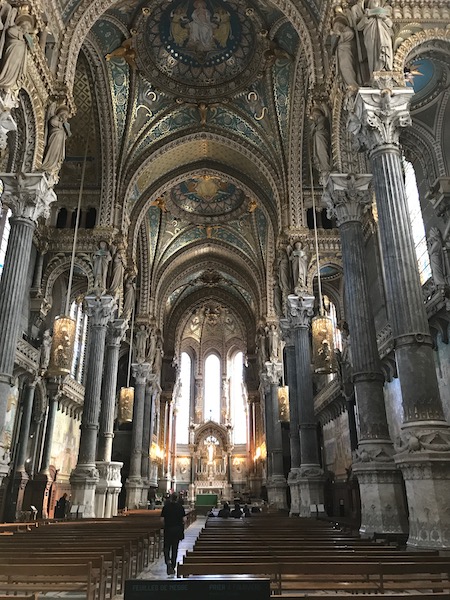Our Blog - Lyon Basilica
I don't normally do a blog entry for just one church, but I had so many pictures and information that I thought it was making the other blog just too long. So I thought I would break it out. I did leave the various "from a distance" pictures where they were, so this covers the time when we went up to the Basilica itself.
You've seen pictures of the Basilica from various points at the bottom of the hill (river-level), and now you can see it from the top of the hill as well. It was built with private funds between 1872 and 1884 overlooking the city of the site that was once the Roman forum of Traja. It is dedicated to the Virgin Mary, to whom is attributed the salvation of the city of Lyon from the bubonic plague that swept Europe in 1643. The design draws from both Romanesque and Byzantine architecture, two non-Gothic models that were unusual choices at the time. Another unusual fact is that it is actually two churches, one on top of the other. The upper sanctuary is very ornate, while the lower is a much simpler design. The most visible feature of the Fourvière basilica is to have four corner towers, two on the front and two at the beginning of the choir. The small chapel on the right side is called Saint Mary's Chapel.


The ornamentation of the frieze and the foot of the towers strongly contrasts with the other walls. Here you can specifically see the Byzantine architecture.



The higher Church is dominated by 3 domes and lit by 6 stained-glass windows offering a light emphasizing a rich decor. The materials used for the building and the decoration rival in quality and beauty, white marble from Carrara, pink granite from the North of Italy, blue marble from Savoy, green onyx, silver and gold pieces, union of ebony and ivory.







On the side walls, there are large mosaics that show the link of Mary to the Church and the relationship of Mary with France.



Another mosaic shows Joan of Arc, who was already a strong symbol of France at the time when the Basilica was built.


This mosaic is about Saint Jacques de Compostela and is actually a recent mosaic, done in 2004. The numbers indicate scenes from the life and legend of Saint James and the letters are for stops at cities/towns along the way to Compostela.


This is a sculpture that was created in 1897, depicting Mary presented at the temple.

Then you head down to the lower church, and you definitely see the difference in the decor. The ceiling here is much lower, and it is not as elaborately decorated. It still is pretty nice compared to some churches. It is dedicated to Joseph and the architecture and design is specific to the story that the architect wanted to tell. The dichotomy of the buildings (upper elaborate church and lower more somber church) shows the necessary path for a pilgrim, who passes from relative obscurity (the rather low church) to the light (the great spaces of the high church). In the same idea, Joseph represents both the dark side of the Holy Family, the physical support of his wife and child of Jesus, but also the tradition and the Old Testament.






Then Saint Mary's chapel was founded in 1192, partly demolished in 1562 during the French wars of religion, then rebuilt, it was updated in 1851.



Go straight to Lyon Day 3
Go back to the main Lyon blog page.